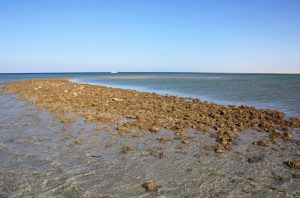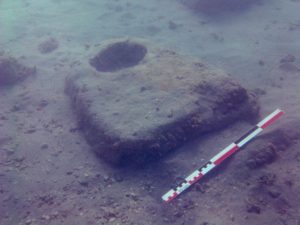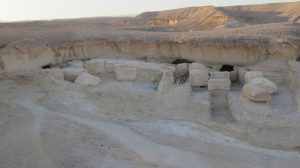Archaeologists believe to have found the harbour at the Red Sea near Wadi el-Jarf, Egypt, built 4600 years ago and used by the Pharaoh to import things used in construction of the Great Pyramid of Giza.

The monumental harbor discovered under the waves at Wadi el-Jarf has been dated to 4,600 years ago, right in Cheops’ time. Cheops, also known by his Egyptian name Khufu, reigned from 2580 to 2550 BC He had the harbour erected 180 kilometres south of Suez, in the foothills of the desert mountains. The site was found near a huge archive of papyri, which is also the oldest known to date, and which describe how the harbour was built and used by the great King Cheops to import materials to build his most significant monument, the Great Pyramid of Giza.

Ancient Egyptians traded briskly with peoples around the region, operating from coastal towns on both the Red Sea and the Mediterranean. The ancient Egyptians may have built the harbour to secure their supply of strategic resources, such as copper and turquoise, which were mined in the southern Sinai. The discoveries at Wadi el-Jarf include a monumental 200-metre long L-shaped pier built of large limestone blocks, 22 limestone ship anchors in situ in the mooring area, which probably fell off ships, large storage jars lying on the seabed. The pier also functioned as a breakwater, offering sheltered anchorage for the boats moored within.

Additionally, the archaeologists also discovered several pottery kilns, attesting to local ceramic production. Thousands of locally made globular storage jars were found everywhere throughout the site. Next to the wharf, the archaeologists found the remains of large stone structures, measuring 30 meters long by 8 to 12 meters in width, which may have been used as administrative centres for the port’s operations, and possibly also to store material and foods for the miners working in Sinai or even provided accommodation to teams briefly staying on the coast.

The galleries hewn from the rock lie six kilometres from shore. The tunnels carved into the hill measure about 3 metres in width and 15 to 20 metres in length, though some galleries were over 34 metres long. Each gallery was narrowed by a series of large blocks of limestone and was finally sealed by a last block, arranged as a sort of gate. The galleries were used for storage, from oars to tools to food and water supplies. Within them a number of inscribed papyri were found, as well as hundreds of pieces of wood, fragments of oars, and sections of ropes

The discovered archive of around 800 pieces of papyri, dating to the reign of Cheops reign, is the oldest papyrus archive ever found in Egypt, according to the Egyptian Institute of Antiquities. The ancient documents were extraordinarily well preserved as some sheets were as much as a meter long. Some of the documents are accounts organized in tables, other are logbooks recording everyday activities of a team led by an inspector named Merer, an official from Memphis.
(after Haaretz & Pierre Tallet)